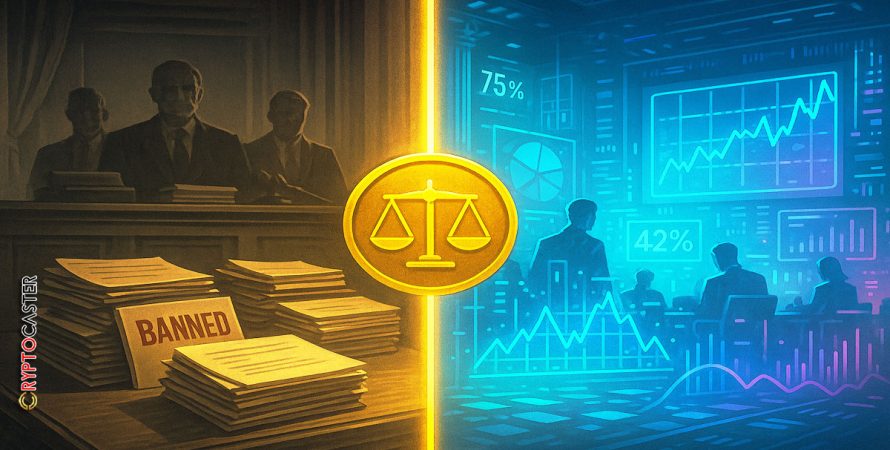By CryptoCaster Editorial Desk | October 10, 2025
The Return of a Controversial Market
Polymarket, the world’s largest blockchain-based prediction market, is back in the U.S. — a country that once pushed it out with a sweeping ban. After years of regulatory uncertainty, the platform has reentered under a new legal framework, marking one of the most intriguing comebacks in crypto history.
Stay in the know on crypto by frequently visiting Crypto News Today
The story of Polymarket is about more than just a platform. It’s a case study in how innovation often collides with regulation, how governments react when a new technology grows too fast, and how persistence — backed by compliance engineering — can force regulators to adapt.
For readers, the message is clear: prediction markets, once dismissed as fringe gambling experiments, are maturing into serious financial instruments. And Polymarket is the tip of the spear.
CryptoCaster Quick Check:
Why Polymarket Was Different
To understand the comeback, you first have to understand why regulators came down so hard in the first place.
Centralized exchanges (CEXs) like Coinbase, and decentralized exchanges (DEXs) like Uniswap, could be squeezed into existing legal categories: securities brokers, commodities markets, or money transmitters. Imperfect fits, but categories nonetheless.
Polymarket didn’t fit anywhere. It wasn’t exactly gambling. It wasn’t exactly derivatives. It wasn’t exactly polling. Instead, it let people bet on anything: elections, inflation, wars, sports. Prices in its markets reflected crowd-implied probabilities — essentially live forecasts on world events.
That success was threatening. Media outlets began citing Polymarket prices the way they’d cite polls. Traders treated it as a forecasting tool. For regulators, this wasn’t just financial speculation — it looked like a parallel system for truth discovery, one that could influence elections, public policy, even markets themselves.
So the reflex was simple: shut it down.
The Ban and the Freeze
In 2022, the Commodity Futures Trading Commission (CFTC) moved against Polymarket, forcing it to block U.S. users. The logic was straightforward: these were unregistered event contracts, and without oversight, they posed systemic risk.
Behind the scenes, officials were equally worried about perception. If a thinly traded blockchain market showed “Candidate X 70% to win,” would that sway voters or financial flows? Was that information, or manipulation?
Instead of wrestling with nuance, regulators did what they often do when a novel category emerges: they issued an across-the-spectrum freeze.
How the System Blinked
Fast forward to 2025, and the same regulators are allowing Polymarket back in. What changed?
- QCEX Acquisition
Polymarket acquired QCEX, a U.S. derivatives exchange and clearinghouse licensed by the CFTC. That gave it a compliant wrapper — the regulatory box it lacked before. - No-Action Relief
The CFTC issued a “no-action letter,” essentially waiving certain requirements for event contracts. This was not a free pass, but it signaled a willingness to let the experiment run under close supervision. - Case Closure
Both the DOJ and CFTC investigations into Polymarket’s earlier activities were closed without charges. The legal cloud that once hung over the platform cleared.
In other words: Polymarket didn’t change what it is, it changed how it’s wrapped. And regulators, under pressure to show they can innovate without ceding ground to offshore markets, found a way to say yes.
The Deeper Tension
At its heart, the Polymarket saga reveals the system’s deeper fear: prediction markets can work too well.
They aggregate information faster than polls, often more accurately than experts, and without the spin of political campaigns. If the price of “Inflation above 5% by year-end” is trading at 80 cents, that’s a market verdict. If “Candidate Y wins the presidency” trades at 65 cents, that’s a forecast.
To regulators, that kind of clarity is double-edged:
- Valuable: as a transparent, crowd-driven probability signal.
- Dangerous: because it can shift sentiment, policy debates, even voting behavior.
This is why Polymarket was treated more harshly than Coinbase. It wasn’t just money. It was narrative power.
Why It Matters Now
Polymarket’s U.S. return isn’t just a headline. It signals a new era where prediction markets are:
- Legitimized → No longer shadow tools, but regulated instruments.
- Accessible → Retail and institutions alike can use them under clearer rules.
- Strategic → For traders, hedgers, and even governments, they offer a live pulse of public expectations.
This comes at a crucial time:
- The 2026 U.S. elections loom large.
- Global conflicts and interest rate battles make forecasting tools more valuable than ever.
- DeFi, AI, and tokenization are colliding, and prediction markets could serve as real-time data feeds for agentic economies.
The Road Ahead
Will Polymarket thrive in its second life? That depends on liquidity, user trust, and how tightly regulators leash it. But the larger arc is undeniable: prediction markets are moving from the shadows into the mainstream.
In 2015, Augur was dismissed as an oddity. In 2022, Polymarket was shut down as a threat. By 2025, it is back, licensed, and framed as an experiment in financial foresight.
That arc tells us something simple but profound: the system can resist innovation, but when the future is too useful to ban, it eventually adapts.
Bottom Line
Polymarket’s U.S. return is more than a regulatory win. It’s a signal that the world is ready — reluctantly, but inevitably — to accept prediction markets as part of the financial landscape.
For crypto, it’s validation. For regulators, it’s a compromise. For readers, it’s a reminder: the future isn’t just coming. It’s tradable.
If this article brought you clarity, insight, or value—support the work that made it possible.
At CryptoCaster, we report on Web3, crypto markets, and institutional finance with no billionaire owners, no shareholders, and no hidden agenda. While mainstream media bends toward Elon Musk, BlackRock, and JPMorgan narratives, we stay focused on what matters: truth, transparency, and the public interest.
We don’t just cover the headlines—we investigate the power structures behind them. From FTX and Ripple to the quiet push for CBDCs, we bring fearless reporting that isn’t filtered by corporate interests.
CryptoCaster is 100% paywall-free. Always has been. To keep it that way, we depend on readers like you.
If you believe independent crypto journalism matters, please contribute—starting at just $1 in Bitcoin or Ether. Wallet addresses are below.
Your support keeps us free, bold, and accountable to no one but you.
Thank you,
Kristin Steinbeck
Editor, CryptoCaster
Support CryptoCaster: The Unfolding of Money
At CryptoCaster.world, we’re dedicated to bold journalism, sharp insights, and fearless commentary across blockchain, Web3, and crypto markets. Your **Bitcoin contributions** help us stay independent and continue delivering signal over noise.
🚨 CryptoCaster does not offer investment advice. Always DYOR—volatility is real, and risk tolerance matters.
Support our mission. Contribute BTC today.
🔗 Bitcoin Address:
3NM7AAdxxaJ7jUhZ2nyfgcheWkrquvCzRm
Thank you for backing our journalistic lens as we chronicle the Unfolding of Money — a saga still being written in real time.![]()
CRYPTOCASTER HEATMAP








